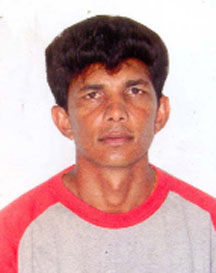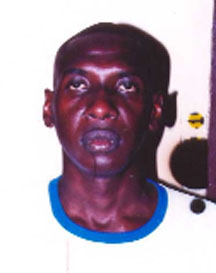A new police witness yesterday testified that the bullet recovered from the body of Chandrapaul Persaud was discharged from the AK-47 Assault Rifle that was found with murder accused Cyon Collier, called ‘Picture Boy.’
It is alleged that Collier murdered Persaud, 34, called ‘Kero Man,’ on September 30, 2006. Persaud was shot by one of three gunmen who launched an attack on him outside his Non Pareil, East Coast Demerara home, minutes after he drove his vehicle into the yard.
Sergeant Eon Jackson took to the stand and stated that on October 3, 2006, Captain Floyd Hosannah gave him an envelope containing two spent casings. That same day, he said, Sergeant Chabinauth Singh gave him a fired bullet. Singh had earlier indicated that it was a 7.62 x 39 bullet that was removed from Persaud’s body by pathologist Dr. Nehaul Singh during the post-mortem examination. Hosannah too had testified that the two casings were picked up from the veranda of Persaud’s home and taken to Jackson, who said the two casings were 7.62 x 39.

On October 5, 2006, Assistant Superintendent of Police Michael Kingston submitted to Jackson an AK-47 Assault Rifle with a magazine and 13 7.62 x 39 rounds.
Jackson told the court that he fired three rounds from the rifle and found it to be a firearm in working order. He then compared the bullet taken from Persaud’s body and the two casings with the rounds he had discharged. He found they had the same firing pin impressions and striation marks in identical sequence to that on the AK-47 rifle.
He told the jury that the bullet and the casings were discharged from the AK-47 Assault Rifle which had serial number 11081 given to him by Kingston. The striation marks on the bullet, he said, are the signature of the weapon and cannot be reproduced by another weapon. It is unique to the individual weapon, he added.

State Prosecutor Judith Gildharie-Mursalin asked Sergeant Jackson to demonstrate for the jury the action required to discharge rounds from the rifle. Jackson demonstrated how the 30-round magazine is inserted, how the cocking arm is pulled up and how the trigger is squeezed.
He explained that the safety level sets the stage at which the rounds are fired –singularly, in rapid bursts of three to four rounds at a time or in rapid automatic fire, depending on how long the finger on the trigger is depressed. He was asked to check the weapon for the serial number he mentioned and he was required to remove the top cover to see the serial number on the inside, since the serial number on the outside had been filed off. He pointed out on the inside where the serial number was 11081.
He said he compared this serial number to a list of numbers of the missing army weapons supplied to him and confirmed that it belonged to the army.
Sergeant Jackson had earlier on testified about his qualifications and training received in relation to firearms and ammunition in Barbados and USA. By 2006, he had been working in the Ballistics section at CID for 11 years.
In the 11 years, he had examined between 900 and 1,000 weapons and about 10,000 bullets. He has testified more than 250 times in the courts of Guyana.
Gildharie-Mursalin had applied for Jackson to be deemed an expert in firearms and ammunition and defence counsel Lyndon Amsterdam objected. However, Justice Winston Patterson overruled the objection and deemed Jackson an expert in the field of firearms and ammunition.
The trial was adjourned to October 27, due to Amsterdam’s request to cross-examine pathologist Singh, who would not be available until the said date.
The state’s case is being led by Gildharie-Mursalin while Collier is being represented by Amsterdam, Keshia Chase and Yolanda Lamott.




